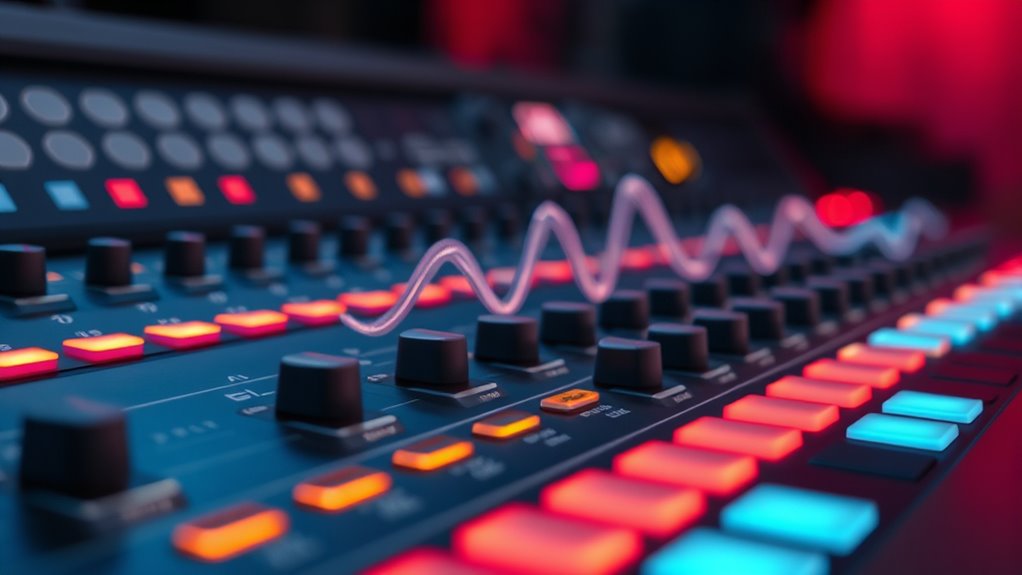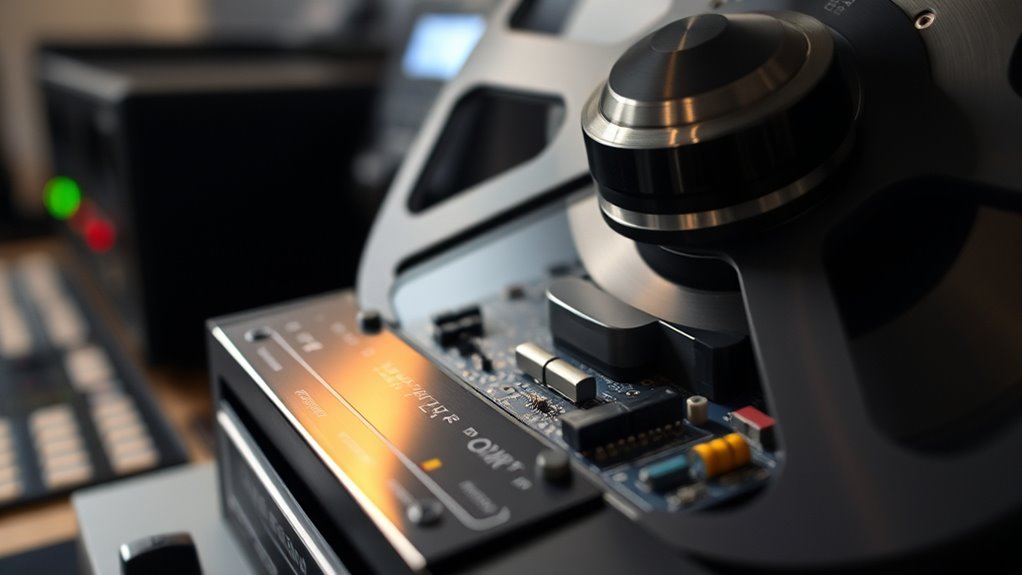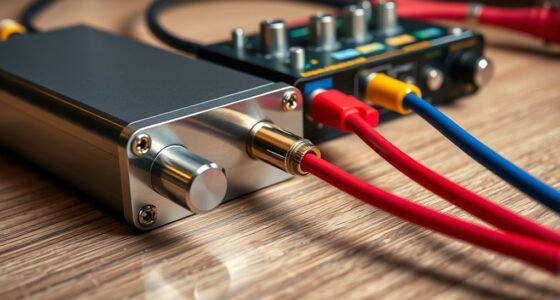In practice, you use dither by adding subtle noise to your audio to hide quantization artifacts, especially during quiet passages. Noise shaping directs this residual noise into less perceptible high-frequency ranges, aligning with how the ear perceives sound. Together, these techniques improve digital audio quality by masking distortions and making the sound feel more natural. Continuing with these practices can help you achieve professional, high-fidelity results in your audio projects.
Key Takeaways
- Dither adds low-level noise to mask quantization artifacts, making digital audio sound more natural, especially at lower bit depths.
- Noise shaping manipulates the spectral distribution of the dither noise to reduce its audibility in sensitive frequency ranges.
- Combining dither and noise shaping effectively minimizes perceptible distortion during quiet or smooth audio passages.
- Practical applications include CD mastering and digital archiving, where maintaining audio fidelity with limited bits is essential.
- Psychoacoustic principles guide the design of dither and noise shaping to align residual noise with human hearing sensitivities.

Have you ever wondered how digital audio maintains high quality despite reducing bit depth? It’s a fascinating process involving techniques like dither and noise shaping. When converting analog sound to digital, you’re faced with the challenge of quantization, which inevitably introduces quantization artifacts—tiny, unwanted distortions that can make audio sound harsh or grainy. These artifacts happen because digital systems must round off the amplitude of the audio signal to fit the limited number of bits available, and this rounding process creates a layer of quantization noise. To combat this, engineers add a subtle layer of noise—called dither—that masks these artifacts and makes the resulting sound more natural. Think of dither as a gentle veil that spreads out the quantization errors, preventing them from becoming perceptible as harsh distortions.
Dither masks quantization artifacts, making digital audio sound more natural despite reduced bit depth.
But adding noise isn’t enough on its own. That’s where noise shaping comes into play. Noise shaping manipulates the spectral distribution of the added noise, pushing it into less audible frequency ranges. Our ears are less sensitive to certain frequencies, especially high frequencies, thanks to psychoacoustic masking. This phenomenon means that louder sounds at certain frequencies can hide quieter sounds nearby, allowing noise shaping algorithms to concentrate the noise energy where it’s less noticeable. By aligning the noise spectrum with the ear’s masking capabilities, noise shaping makes the quantization noise less perceptible, thereby preserving the audio’s perceived fidelity. Additionally, understanding sound perception principles helps engineers optimize the balance between audio quality and data efficiency.
In practice, these techniques work hand in hand. When you apply dither during digital audio processing, it reduces the perception of quantization artifacts, especially in quiet or smooth passages. Without dither, the artifacts can become painfully obvious, especially during subtle dynamic changes. Noise shaping then takes this a step further by directing the residual noise into frequency ranges where your ears are less sensitive, effectively hiding imperfections. This combination allows you to maintain a high-quality sound even at lower bit depths, which is essential in applications like CD mastering and digital audio archiving.
It’s important to understand that both dither and noise shaping rely heavily on psychoacoustic principles. By understanding how your ears perceive sound, engineers can craft noise profiles that are less intrusive, making the digital audio experience feel more natural and immersive. So, next time you listen to a high-quality digital recording, remember that these sophisticated techniques are working behind the scenes to keep your listening experience pristine, despite the limitations of digital quantization.
Frequently Asked Questions
How Do I Choose the Best Dither Type for My Project?
To choose the best dither type for your project, consider your audio’s final use and the noise shaping techniques you want to apply. Start with simple options like rectangular or triangular dither for transparent results, then experiment with shaped dither such as shaped noise or TPQ dither to minimize audible artifacts. Your goal is to match dither selection to your audio’s characteristics, balancing transparency and noise shaping effectiveness.
Can Noise Shaping Be Applied to All Audio Formats?
You might think noise shaping can’t be applied to all digital audio formats, but it actually can improve most. While some formats like PCM or high-resolution files support it well, others may have limited compatibility. Noise shaping reduces quantization noise effectively, but always check your target format’s specs to guarantee compatibility. By doing so, you maximize audio quality across various formats, making noise shaping a versatile tool in your production process.
What Are the Potential Drawbacks of Using Noise Shaping?
Using noise shaping can sometimes lead to artifact accumulation, where unwanted noise becomes more noticeable in certain frequency ranges. It may also cause issues with frequency masking, making some sounds less perceptible while emphasizing others. These drawbacks can degrade audio quality if not carefully managed. You should weigh these potential problems against the benefits, ensuring noise shaping enhances your sound without introducing distracting artifacts or masking important audio details.
How Does Dither Affect the Perceived Audio Quality?
Imagine a gentle mist settling over a rough landscape—that’s what dither does to perceived audio quality. It smooths out harsh digital errors, making your listener experience feel more natural and immersive. Without it, audio can sound jagged or grainy, disrupting your enjoyment. Dither subtly hides imperfections, enhancing clarity and warmth, so your ears receive a cleaner, more pleasing soundscape that feels as rich and inviting as a cozy evening by the fire.
Are There Industry Standards for Implementing Dither and Noise Shaping?
Yes, industry standards guide how you implement dither and noise shaping. You should follow established dither algorithms like Triangular PDF or Shaped Dither, which are widely accepted for their effectiveness. Noise shaping standards, such as those recommended by the AES or ITU-R, help you minimize perceptible noise. By adhering to these guidelines, you guarantee your audio maintains high quality and consistency across different platforms and formats.
Conclusion
Think of dither and noise shaping as your musical compass, guiding your sound through the fog of quantization. They’re the quiet artisans, shaping chaos into clarity, transforming digital whispers into a symphony of precision. Embrace these tools as your loyal guides, turning potential distortion into shimmering clarity. With them, you steer your audio journey toward purity, where every note resonates with purpose—like a lighthouse piercing through the night, illuminating the path to sonic perfection.










